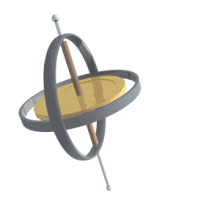Spin modulation is seen on both magnetometers and sun sensors at ∼6.5 Hz. Modulation envelope varies due to the slow precession of the spin axis during flight.
For the flight shown in figures 4 and 5, the sensor data around 1 s after release were best fitted with an elevation of 70◦ (i.e., spin axis was 20◦ from vertical) and an azimuth of 120◦ (i.e., the spin axis was tilted towards WNW). If the disc was flying horizontally in an ESE direction, it would therefore have a 20◦ angle of attack (see figure 8 for the relationship of the body sensor axes to lift and drag, and the definition of angle of attack and flight path angle).
At ∼2.5 s, shortly before impact, the attitude has precessed due to the disc's pitch moment. The best-fit attitude has an elevation of 60◦ and a heading of 150◦. This corresponds to a precession of about 14◦ in total. Inspection of the flight data suggests that this change occurred principally between 1.5 s and 2.5 s into the flight, and there was a slight change in the opposite direction immediately after release.
The radial accelerometer is spin modulated as expected about its zero value of 170 DN, though with some twice-per-rotation nutation signal just after launch. Hummel has similarly observed nutation in the first second or so of Frisbee flight—the nutation is caused by the angular momentum vector imparted by the thrower being misaligned with the axis of maximum moment of inertia. Energy dissipation, either by flexing of the disc or by aerodynamic forces, tends to damp this nutation quickly. The axial accelerometer shows spin modulation (coning) due to sensor misalignment with principal axis, about a near-constant flight signal of ∼1.3g.
Figure 7 shows the record from the microphone sensor on the upper surface near the rim of the disc. This too shows a spin modulation, as the microphone sweeps round from leading to trailing side, suggesting it responds to the airflow immediately adjacent to the disc surface. The modulation varies somewhat throughout the flight due to the variation in flight speed and the angle of attack.
The determination of the spin axis and phase of a rotating vehicle is of course a standard problem in spacecraft attitude dynamics, and a combination of sun sensor and magnetometer is often used. A major difference here is that the spin axis of a Frisbee in flight is being precessed rapidly, whereas the generally very small disturbance torques in space mean a spacecraft is likely to maintain a constant spin axis and rate over periods of weeks, and a variety of filtering approaches can be used to estimate the attitude. As one example, ground software used sensors on the DARPASAT satellite spinning at 20 rpm to generate attitude estimates of better than 1◦ from 2 min of data, i.e. 40 spin periods. The discs here can only be considered to have a pseudoconstant attitude for around five spin periods. (It may be noted in passing that sensor data on DARPASAT, a vehicle three–four orders of magnitude higher in cost than the instrumented disc, also show nutation and coning signals.)
Modest spin modulation is therefore evident in its flight data (e.g. at one point in flight 6, the reading varies 20–45; later the variation is 25–70).
Figure 9 shows the radial accelerometer record towards the end of flight, with magnetometer 1 overlain as a phase reference. It can be seen that the acceleration peaks before the magnetometer, indicating a particular heading. However, within four spin periods (∼0.6 s) the phase reverses, with the acceleration peaking after the magnetometer. This does not indicate a 180◦ turn in flight, but rather the changing dominance of the two terms that contribute to the radial acceleration (D cos(α) − L sin(α))/M, where M is the mass of the disc (0.26 kg) and other terms are defined in figure 8. Usingalinearfit(Cl =0.2045+0.0495α)totheliftcoefficient data of Potts and Crowther [3], and a parabolic fit to the drag coefficient, namely Cd = 0.118 + 0.0069α + 0.0007α2, the net radial force coefficient Cd cos(α) − Cl sin(α) can be calculated, and is shown in figure 9(b).
It is seen that this function has a maximum value at a modest angle of attack (∼8◦, coincidentally close to the angle at which a disc has zero pitch moment, i.e. flies in trim). Between 20◦ and 35◦, the function decreases rapidly and becomes negative. It is this change of sign that is responsible for the change in phase of the radial acceleration signal.
